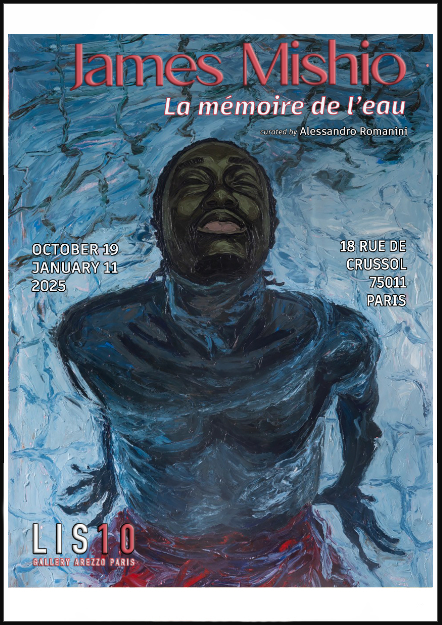
Despite his youth, James Mishio (b. 1997 - Accra, Ghana), has managed to create a markedly personal style in which content, form and technique come together harmoniously. This is demonstrated by the works on show in the exhibition ‘The Memory of Water’, curated by Alessandro Romanini and hosted at the Lis10 Gallery in Paris.
With the title of the exhibition, created especially for the Parisian event, the Ghanaian artist refers to the alleged pseudoscientific property of water to maintain the memory of substances with which it has come into contact, which in the case of his paintings becomes amniotic fluid and the vector of memories, historical events and identity memories.
His characters are often immersed in the water element or appear in the background to remind us at the same time of the power of nature, of the unmotivated violence of the principles of the Anthropocene and above all of the need to develop forms of thought and praxis, in balance with the various components of existence.
Above all, the young Ghanaian artist's expressive strategy aims to highlight the power of painting as a tool for representing the zeitgeist and above all as a device that encourages the observer to reflect and the author himself to question himself.
Mishio emphasizes the subversive power of painting, giving life to a rich and articulated anthropological and symbolic universe, which the skillful use of the paintbrush declines in a harmonious scenographic dimension, which is structured on a circumscribed chromatic range, which renounces bright tones and easy decorative effects, in order to convey the underlying concept.
The artist often uses the liquid element to multiply the points of view and fragment the composition, exploiting the principles of reflection and refraction, offering the observer the possibility of further and subjective fruition.
He opts for technical solutions that engage the perceptive apparatus of the observer, freeing him from the passive fruition typical of media communication, in which images are deprived of communicative foundation.
James Mishio is interested in painting as an instrument that since the origins of humanity, in caves, stimulated our ancestors to record pictorially on the walls of caves events of daily life, to transmit memory to posterity and above all to investigate what exists.
That same painting, which today, undermined by technological media, does not cease to nourish our gaze by virtue of its bi-univocal link with our genetic predisposition to the vision of ‘representative’ images, which refer to a mythopoeic universe that the Ghanaian artist has been able to structure.
His is a painting that is ‘liquid’ in the application of color but solid in its structure, that does not impose unambiguous visions but invites debate, that structures spaces and characters from everyday life, including personal life, which are elevated to the status of universal reflection.
Above all, his is a style that eliminates visual roughness, limiting the color palette, in order to focus attention on the theme and free his painting from the identity claims typical of the post-colonial phase.
Mishio, already the protagonist of important international exhibitions such as the one held at the Ettore Fico Museum in Turin in 2024, pictorially reaffirms the total assimilation of a dual identity, in which historical identity roots and contemporary global culture coexist.
In the lively contemporary African artistic and cultural scene in general and Ghanaian in particular, Mishio has been able to create a pictorial syntax that does not neglect the search for a form of identity self-representation, but which synergistically joins the debate on contemporary globalized iconography and harmoniously holds together, ethics and aesthetics.